St. George's Forane Church, Edappally
St. George's Syro Malabar Forane Church, locally known as Edapally Church is a Catholic pilgrimage church in Edapally, Kochi, India. Asia's largest shrine to Saint George, about five million people visit it every year.
| St. George's Syro Malabar Forane Church | |
|---|---|
| St. George's Forane Church | |
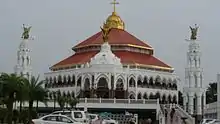 | |
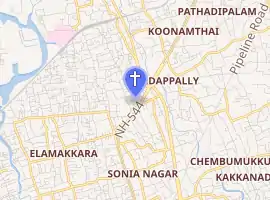
| |
| 10°1′19″N 76°18′19″E | |
| Location | Edappally, Kochi |
| Country | India |
| Denomination | Syro-Malabar Catholic Church |
| Website | stgeorgeedappally |
| History | |
| Former name(s) | Mart Mariam Church |
| Status | Church |
| Founded | c. AD 593 |
| Dedication | Saint George (Formerly Mary) |
| Consecrated | 19 April 2015 |
| Architecture | |
| Functional status | Active |
| Architect(s) | Zeril Jose and Koshy akex, Vastushilpalaya, Prasanth P George |
| Groundbreaking | 1 January 2001 |
| Completed | 19 April 2015 |
The church is thought to have been founded in 593 AD. It is regarded as one of the oldest churches in Kerala, after the seven churches founded by Thomas the Apostle in the first century AD. The church was originally dedicated to the Marth Mariam (Virgin Mary).[1][2] In 1080, a new church was built adjacent to the old church.[3] A nine-day festival is celebrated annually as part of the Feast of Saint George (23 April).[4][2] The church, also a destination for non-Christians,[4][2] attracts offerings of gold, chicken, and eggs.[3][4][5]
St. George's Forane Church, north-east of Kochi, is 500 metres from the intersection of NH 66 and NH 544. The nearest airport is Cochin International Airport in Nedumbassery, about 22 km from the church. The Edappally railway station is 3 kilometres (1.9 mi) away.[6] Kochi Metro, the city's rail network, runs in front of the church.[7]
History

The church has a 14-century history. Its perennial well attracted many people, and the church became a pilgrimage site.
According to historians, Thomas the Apostle (Mar Thoma Sleeha in Malayalam/Syriac) built seven churches. The Edapally church was built during the sixth century, shortly after the construction of the seven churches.
A statue of St. George (Mar Geevarghese Sahada) on horseback, stabbing a serpent under his horse's hooves, is prominent. The church blends religion, magic, myth, folklore and history.[3] Edappally was a hamlet, part of the princely kingdom of Elangalloor.[8] Its Syrian Christian congregation was small,[3] descendants of those who were converted to Christianity by St. Thomas the Apostle (who came to India in 52 AD). The oldest Edappally church was built in 593, and the one-room building is preserved as a storehouse. It was built by families from Paravur who had to travel to the Kottakkavu Mar Thoma Syro-Malabar Church, North Paravur to worship.
The congregation outgrew the old church, and a second church was built in 1080.[2][9] Its main madbaha/altar and facade were renovated during the 1970s, and a picture of the Virgin Mary was added.[9] The imported-tile floor remains.
The 1400th anniversary of the church's founding was celebrated on 18 January 1994. Mother Teresa visited from Calcutta as the chief guest.[10] To commemorate the occasion, a bell tower was constructed on the church premises and a bell installed. The bell was later moved to the archangel tower of the new church.
The foundation stone for the third church, blessed by Pope John Paul II,[11] was laid on 1 January 2001.[12] The octagonal, 141-foot-high (43 m) church covers a 88,000-square-foot (8,200 m2) area, and is one of India's largest churches.[12] Blending European and Keralite architecture, its madbaha/altar is made of teak covered with gold foil imported from Italy and it has two bell towers.[13][14] Old (original sin, Noah's Ark and Cain and Abel) and New Testament scenes (the story of Jesus) are depicted as sculptures. The altar, depicting the Resurrection, is surrounded by carvings in Vietnamese marble. The 19,500-square-foot (1,810 m2) main chapel has a capacity of 5,000, and theoo entire church can hold 10,000 people.[12] The two older churches have been preserved for their historic importance.[15]
Vastushilpalaya and Prasanth P George were the new church's architects.[12] The church courtyard has a well, and devotees believe that its water has curative powers.[3]
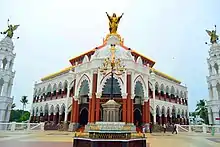
Organizations
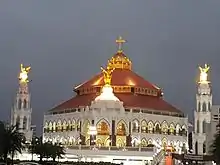
Darsana Samooham is a lay religious organisation associated with the church, dedicated to the Virgin Mary or a saint connected with a religious order.[16] Edappally's Darsana Samooham is the world's largest. Members usually wear religious dress. It is governed by an elected committee which includes a president, treasurer, and secretary. The Edappally's Darsana Samooham helps organize the annual feast and participates in the festival procession.[17]
The Marian Sodality, founded by Payyappilly Joseph Kathanar in 1927, promotes spirituality among parish youth.[18] Similarly, the Cherupushpa Mission League (founded in 1972) works to instill Christian values in the youth of the parish. Thirubalasakyam is a children's organization associated with the church, and most children in the parish are members.
St. Joseph's Maranananthara Sahaya Fund is an association of parish members to assist financially stressed parish families with funeral expenses.[18] It is funded by life memberships or monthly subscriptions collected from members. St. George's Charitable Fund is managed by the church to provide financial assistance to the poor, regardless of religion.
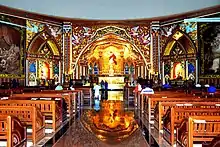
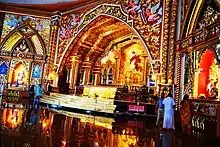
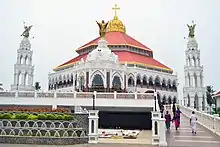
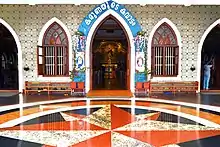
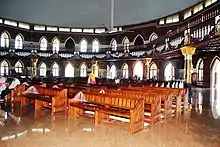
Mar Geevarghese Sahada
The church was built about 300 years after the martyrdom of Saint George (Mar Geevarghese Sahada). Mar Geevarghese is known to have born in Lod, Syria Palaestina around AD 275–285 .[5] A soldier, he reached the rank of tribunus in the imperial guard of the Emperor Diocletian at Nicomedia.[5] Mar Geevarghese was a believer in Christ and lived his life according to the scriptures.[5] During the Diocletianic Persecution, he defended his faith and was put to death.[5] Many churches sprang up throughout Europe and parts of the East dedicated to St. George, the patron saint of England.[19]
The Edappally church became known as St. George's Church. The statue of St. George on horseback depicts the saint and his horse killing a serpent, a symbol of Satan.[19][20]
See also
References
- http://deepika.epapr.in/c/5008080
- "Indian cardinal does a Pope Francis at church blessing". Matters India. 20 April 2015. Retrieved 14 June 2015.
- "Between the old and the new church". The Hindu. 17 April 2015. Retrieved 14 June 2015.
- "St. George's Miraculous Syro Malabar Catholic Forane Church". Web India 123. 2015. Retrieved 14 June 2015.
- "Edappally Church, Kochi, Kerala, India". Tourfilla. 2015. Retrieved 14 June 2015.
- "Makeover for Edappally railway station likely". Times of India. 29 December 2014. Retrieved 15 June 2015.
- "Kochi Metro route". Railway Technology. 2015. Retrieved 15 June 2015.
- "Temple history". Thrikkannapuram Temple. 2015. Retrieved 14 June 2015.
- "Kerala Tourism". Government of Kerala. 2015. Retrieved 14 June 2015.
- "Kochi remembers Mother". The Hindu. 19 October 2003. Retrieved 14 June 2015.
- "Consecrated on Birthday". Almaya Sabdam. 2015. Retrieved 14 June 2015.
- "Consecration of St George Forane Church Held". New Indian Express. 20 April 2015. Retrieved 14 June 2015.
- "St George Forane Church consecration today - The Times of India". The Times of India. Retrieved 23 April 2015.
- "An Amalgamation of Style, Piety". Retrieved 23 April 2015.
- Syrian Orthodox Churches in India. Encyclopedia of Christianity. 2015. ISBN 9780802824172. Retrieved 14 June 2015.
- "Darsana Samooham". St. George Forane Church. 27 September 2017. Retrieved 16 July 2019.
- "Edapally Perunal" (PDF). Kerala Tourism. 16 July 2019. Retrieved 16 July 2019.
- Photos -, Kerala (17 July 2015). "Edapally St. George Church". Kerala Photos - Kerala. Retrieved 16 July 2019.
- "St. George". Brittania. 2015. Retrieved 14 June 2015.
- "St.George- Geevarghese Sahada traditions and rituals among Nasranis". Nasrani. 2015. Retrieved 15 June 2015.
External links
| Wikimedia Commons has media related to St. George's Forane Church, Edapally. |
